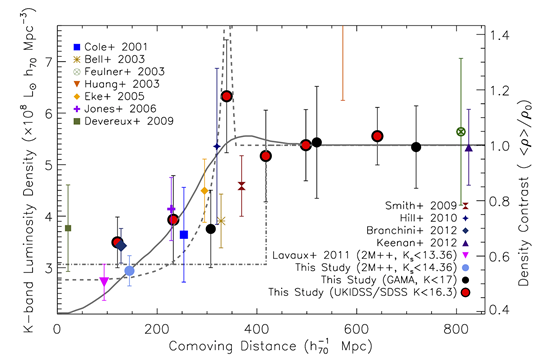Evidence for a 300 Mpc Radius Local Under-density

Near-infrared K-band (2.2 micron) luminosity density as a function of comoving distance in the local universe. Data points show measurements from this study and others from the literature. The right hand vertical axis shows total matter density contrast assuming K-band luminosity density is an unbiased tracer of mass density. The curved lines show radial density profiles from two models that invoke a local under-density to fit the type Ia supernovae data without dark energy. The "step function" shows another model that uses a local under-density to reconcile the discrepancy between local measurements of the Hubble constant and those inferred by Planck.
In this study, we have combined all available K-band photometry and large redshift surveys to probe large-scale inhomogeneity of the local universe via measurement of the K-band luminosity density as a function of distance from us. K-band luminosity is a good tracer of stellar mass, and at low redshifts the stellar mass density of the universe should be an unbiased tracer of the underlying dark matter distribution. Thus, we are making a measurement of the large-scale matter distribution in the local universe. We find that in all directions on the sky the K-band luminosity density appears to be significantly higher beyond distances of ~300 Mpc than that measured locally. Such a large-scale under-density will introduce significant systematics into our locally measured cosmological observables, such as the expansion rate. Models have shown that an under-density of roughly this scale and amplitude could create what looks like an accelerating expansion of the universe, even when no dark energy is present.